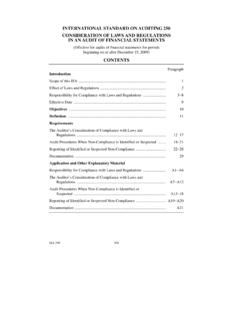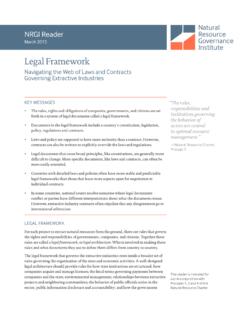Transcription of CMS Manual System
1 CMS Manual System Department of Health & Human Services (DHHS) Pub. 100-07 State Operations Provider Certification Centers for Medicare & Medicaid Services (CMS) Transmittal 77 (Advance Copy) Date: December 22, 2011 SUBJECT: Revised Appendix A, Interpretive Guidelines for Hospitals I. SUMMARY OF CHANGES: Clarification is provided for 42 CFR (c), concerning medication administration. REVISED MATERIAL - EFFECTIVE DATE*: December 22, 2011 IMPLEMENTATION DATE: December 22, 2011 The revision date and transmittal number apply to the red italicized material only. Any other material was previously published and remains unchanged. However, if this revision contains a table of contents, you will receive the new/revised information only, and not the entire table of contents.
2 II. CHANGES IN Manual INSTRUCTIONS: (N/A if Manual not updated.) (R = REVISED, N = NEW, D = DELETED) (Only One Per Row.) R/N/D CHAPTER/SECTION/SUBSECTION/TITLE R Appendix A/ (c) Standard: Preparation and Administration of Drugs/A-0405 III. FUNDING: No additional funding will be provided by CMS; contractor activities are to be carried out within their current operating budgets. IV. ATTACHMENTS: Business Requirements X Manual Instruction Confidential Requirements One-Time Notification Recur r ing Update Notification A-0405 ( , Issued: 12-22-11, Effective/Implementation: 12-22-11) (c) Standard: Preparation and Administration of Drugs Drugs and biologicals must be prepared and administered in accordance with Federal and State laws , the orders of the practitioner or practitioners responsible for the patient s care as specified under (c), and accepted standards of practice.
3 (1) - All drugs and biologicals must be administered by, or under supervision of, nursing or other personnel in accordance with Federal and State laws and regulations , including applicable licensing requirements, and in accordance with the approved medical staff policies and procedures. Interpretive Guidelines (c) and (c)(1) According to the Institute of Medicine of the National Academies, medication errors are among the most common medical errors, harming at least million people each Studies indicate that 400,000 preventable drug-related injuries take place in hospitals each year, as a result of errors that occur at various points in the medication administration Although technological advances in electronic order entry, medication administration, and electronic medical records hold a great deal of promise for decreasing medication errors, there are a multitude of human and environmental factors that will impact their success.
4 The increasing complexity of medical care and patient acuity present significant challenges that require an approach to medication administration that takes advantage of available technology while recognizing that it must be integrated into the medication administration work processes in a manner that meets the needs of patients and promotes their safety. The regulations at (c) and (c)(1) promote safety in the preparation and administration of drugs and biologicals to hospital patients by requiring preparation and administration by or under the supervision of nursing or other personnel in accordance with: Federal and State law; Accepted standards of practice; Orders of the practitioner(s) responsible for the patient s care, as specified under (c); and Medical staff-approved policies and procedures.
5 Federal and State Law 1 Institute of Medicine. Preventing Medication Errors. Washington DC: The National Academies Press, 2007. 2 Reducing and Preventing Adverse Drug Events To Decrease Hospital Costs. Research in Action, Issue 1. AHRQ Publication Number 01-0020, March 2001. Agency for Healthcare Research and Quality, Rockville, MD. Federal law regulates the approval and classification of drugs and biologicals. Individual States establish laws and regulations which specify the scope of practice for various types of licensed healthcare professionals, including which medications they may prescribe and administer, including controlled substances. Accepted Standards of Practice Hospital policies and procedures for the preparation and administration of all drugs and biologicals must not only comply with all applicable Federal and State laws , but also must be consistent with accepted standards of practice based on guidelines or recommendations issued by nationally recognized organizations with expertise in medication preparation and administration.
6 Examples of such organizations include, but are not limited to: National Coordinating Council for Medication Error Reporting and Prevention ( ); Institute for Healthcare Improvement ( ) ; Pharmacopeia ( ) ; Institute for Safe Medication Practices, which offers guidelines specifically on timely medication administration, which can be found at: ; Infusion Nurses Society ( ). In addition, the Centers for Disease Control and Prevention (CDC) publishes evidenced-based practice guidelines and recommendations on medication preparation and administration practices, designed to reduce the risk of infection associated with these activities. Orders of the practitioner or practitioners responsible for the patient s care In accordance with standard practice, all practitioner orders for the administration of drugs and biological must include at least the following: Name of the patient; Age and weight of the patients, or other dose calculation requirements, where applicable; Date and time of the order; Drug name; Dose, frequency, and route; Exact strength or concentration, when applicable; Quantity and/or duration, when applicable; Specific instructions for use, when applicable; and Name of the prescriber.
7 Medical Staff Approved Policies and Procedures The hospital s medical staff must approve policies and procedures for medication administration, consistent with the requirements of Federal and State law and accepted standards of practice. It is recommended that the medical staff consult with nurses, pharmacists, Quality Assessment and Performance Improvement program staff, and others in developing these policies and procedures. The adopted policies and procedures must address key issues related to medication administration, which include but are not limited to: Personnel authorized to administer medication Policies and procedures must identify categories of licensed personnel and the types of medications they are permitted to prepare and administer, in accordance with state laws .
8 The policies and procedures must also address education and training for all personnel preparing and administering drugs and biologicals. Medication preparation and administration education and training is typically included in hospital orientation or other continuing education for nursing staff and other authorized healthcare personnel. Training or continuing education topics regarding medication preparation and administration may include but are not limited to the following: Safe handling and preparation of authorized medications; Knowledge of the indications, side effects, drug interactions, compatibility, and dose limits of administered medications; Equipment, devices, special procedures, and/or techniques required for medication administration; Policies and procedures must address the required components of the training and if the training provided during hospital orientation imparts sufficient education or whether ongoing in-services or continuing education will be required to demonstrate competence.
9 Training content and documentation of competence must be in accordance with (c)(3). See the interpretive guidance for (c)(3) for more detail. Basic safe practices for medication administration The hospital s policies and procedures must reflect accepted standards of practice that require the following be confirmed prior to each administration of medication: the patient s identity. Acceptable patient identifiers include but are not limited to: the patient s full name; an identification number assigned by the hospital; or date of birth. Identifiers must be confirmed by patient wrist band, patient identification card, patient statement (when possible) or other means outlined in the hospital s policy. The patient s identification must be confirmed to be in agreement with the medication administration record and medication labeling prior to medication administration to ensure that the medication is being given to the correct patient.
10 The correct medication, to ensure that the medication being given to the patient matches that prescribed for the patient; the correct dose, to ensure that the dosage of the medication matches the prescribed dose, and that the prescription itself does not reflect an unsafe dosage level ( , a dose that is too high or too low); the correct route, to ensure that the method of administration orally, intramuscular, intravenous, etc., is the appropriate one for that particular medication and patient; and the appropriate time, to ensure adherence to the prescribed frequency and time of administration. Timing of Medication Administration Appropriate timing of medication administration must take into account the complex nature and variability among medications; the indications for which they are prescribed; the clinical situations in which they are administered; and the needs of the patients receiving them.












